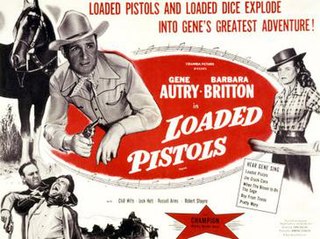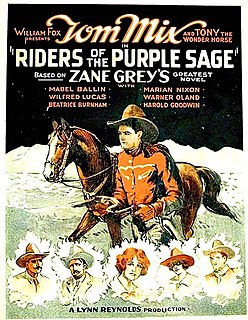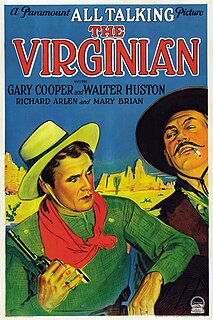 W
W3 Godfathers is a 1948 American Western film directed by John Ford and filmed primarily in Death Valley, California. The screenplay, written by Frank S. Nugent and Laurence Stallings, is based on the 1913 novelette The Three Godfathers by Peter B. Kyne. The story is something of a retelling of the story of the Three Wise Men in an American Western context.
 W
WAcross the Plains is a 1939 American Western film directed by Spencer Gordon Bennet and starring Addison Randall, Frank Yaconelli, and Joyce Bryant. Written by Robert Emmett Tansey, the film is about two brothers who are separated when they are young and who meet again as adults, one good and one bad.
 W
WThe Adventures of Hajji Baba is a 1954 American adventure film directed by Don Weis and starring John Derek and Elaine Stewart. Made in Southern California, it was released on October 1, 1954. In the credits it states that the film is suggested by The Adventures of Hajji Baba of Ispahan by James Justinian Morier. It was the first CinemaScope film made by Allied Artists Pictures.
 W
WThe Adventures of Marco Polo is a 1938 adventure film directed by Archie Mayo and starring Gary Cooper, Sigrid Gurie, and Basil Rathbone. It was one of the most elaborate and costly of Samuel Goldwyn's productions.
 W
WAlong the Great Divide is a 1951 American Western film directed by Raoul Walsh and starring Kirk Douglas, Virginia Mayo, John Agar and Walter Brennan. It was Kirk Douglas's first Western, a genre that served him well during his long career.
 W
WBarbed Wire is a 1952 American Western film directed by George Archainbaud and starring Gene Autry, Anne James, and William Fawcett. Written by Gerald Geraghty, the film is about a cattle buyer who goes to Texas to investigate why the cattle trails to Kansas are blocked.
 W
WBoots and Saddles is a 1937 American Western film directed by Joseph Kane and starring Gene Autry, Smiley Burnette, and Judith Allen. Based on a story by Jack Natteford, the film is about a young Englishman who inherits a ranch that he wants to sell, but is turned into a real Westerner by a singing cowboy.
 W
WCall of the Canyon is a 1942 American Western film directed by Joseph Santley and starring Gene Autry, Smiley Burnette, the Sons of the Pioneers, and Ruth Terry. Based on a story by Maurice Rapf and Olive Cooper, the film is about a singing cowboy who leads a group of cattlemen against the corrupt agent of a large packing company looking to swindle them by undercutting the buying price for beef. The film features three songs by Autry and the Sons of the Pioneers, including the classic "Take Me Back to My Boots and Saddle".
 W
WComin' Round the Mountain is a 1936 Western film directed by Mack V. Wright and starring Gene Autry, Ann Rutherford, and Smiley Burnette. Based on a story by Oliver Drake, the film is about a Pony Express rider who is robbed and left to die in the desert, where he is saved by a wild horse he captures and later uses to round up other horses to be used in the race for a government contract.
 W
WDjango Unchained is a 2012 American revisionist Western film written and directed by Quentin Tarantino, starring Jamie Foxx, Christoph Waltz, Leonardo DiCaprio, Kerry Washington, and Samuel L. Jackson, with Walton Goggins, Dennis Christopher, James Remar, Michael Parks, and Don Johnson in supporting roles. Set in the Old West and Antebellum South, it is a highly-stylized, heavily-revisionist tribute to Spaghetti Westerns, in particular the 1966 Italian film Django by Sergio Corbucci, whose star Franco Nero has a cameo appearance.
 W
WDown Mexico Way is a 1941 American Western film directed by Joseph Santley and starring Gene Autry, Smiley Burnette, and Fay McKenzie. Based on a story by Dorrell and Stuart E. McGowan, the film is about a singing cowboy who comes to the aid of the townspeople of Sage City who are victims of a nefarious scam.
 W
WHangman's Knot is a 1952 American Western film written and directed by Roy Huggins and starring Randolph Scott. The film is about a group of Confederate soldiers, unaware that the Civil War is over, who intercept a shipment of gold escorted by Union cavalry troops and are then pursued by a renegade posse. Hangman's Knot was filmed on location in the Alabama Hills in Lone Pine, California.
 W
WHell Bent for Leather is a 1960 American CinemaScope Eastmancolor Western film directed by George Sherman starring Audie Murphy, Felicia Farr, Stephen McNally and Robert Middleton. The film was based on the 1959 novel Outlaw Marshal by Ray Hogan and filmed on location in the Alabama Hills of Lone Pine, California.
 W
WIn Old Monterey is a 1939 American Western film directed by Joseph Kane and starring Gene Autry, Smiley Burnette, and June Storey. Based on a story by Gerald Geraghty and George Sherman, the film is about an army sergeant and former rancher who runs into opposition from local ranchers when the United States Army sends him to purchase their ranch land needed for a strategic air base.
 W
WThe Lives of a Bengal Lancer is a 1935 American epic-adventure-drama film that used the title of the 1930 autobiography of the British former soldier, Francis Yeats-Brown. The film is a Paramount picture. Henry Hathaway directed, and the writers, who created a story that had nothing in common with Yeats-Brown's book other than the setting, included Grover Jones, William Slavens McNutt, Waldemar Young, John L. Balderston, and Achmed Abdullah.
 W
WLoaded Pistols is a 1948 American Western film directed by John English and starring Gene Autry, Barbara Britton, and Chill Wills. Written by Dwight Cummins and Dorothy Yost, the film is about a cowboy who protects a young man wrongly accused of murder, while trying to find the real badguys.
 W
WThe Lone Ranger is a 2013 American Western action film directed by Gore Verbinski and written by Justin Haythe, Ted Elliott and Terry Rossio. Based on the titular character of the same name, the film stars Johnny Depp as Tonto, the narrator of the events and Armie Hammer as John Reid, the Lone Ranger. The film is told through Tonto's memories of the duo's earliest efforts to subdue local villainy and bring justice to the American Old West. William Fichtner, Barry Pepper, Ruth Wilson, James Badge Dale, Tom Wilkinson and Helena Bonham Carter also are featured in supporting roles. It is the first theatrical film featuring the Lone Ranger and Tonto characters since William A. Fraker's 1981 film, The Legend of the Lone Ranger.
 W
WMelody Ranch is a 1940 Western musical film directed by Joseph Santley and starring Gene Autry, Jimmy Durante, and Ann Miller. Written by Jack Moffitt, F. Hugh Herbert, Bradford Ropes, and Betty Burbridge, the film is about a singing cowboy who returns to his hometown to restore order when his former childhood enemies take over the frontier town. In 2002, the film was added to the National Film Registry by the National Film Preservation Board and selected for preservation as being "culturally, historically, or aesthetically significant."
 W
WThe Nevadan is a 1950 American Cinecolor Western film directed by Gordon Douglas and starring Randolph Scott, Dorothy Malone, Forrest Tucker, Frank Faylen, and George Macready. Written by George W. George and George F. Slavin, the film is about a mysterious stranger who crosses paths with an outlaw bank robber and a greedy rancher. The Nevadan was filmed in Lone Pine, California.
 W
WRiders of the Purple Sage is a 1925 American silent western film directed by Lynn Reynolds and starring Tom Mix, Mabel Ballin, and Warner Oland. Based on the 1912 novel Riders of the Purple Sage by Zane Grey, the film is about a former Texas Ranger who pursues a corrupt lawyer who abducted his married sister and niece. His search leads him to a remote Arizona ranch and the love of a good woman.
 W
WRootin' Tootin' Rhythm is a 1937 American Western film directed by Mack V. Wright and starring Gene Autry, Smiley Burnette, and Armida. Based on a story by Johnston McCulley, the film is about two cowboys who assume the identities of dead outlaws in order to stop a bunch of cattle rustlers, later discovering that the outlaws are far from dead.
 W
WSaboteur is a 1942 American spy thriller film directed by Alfred Hitchcock with a screenplay written by Peter Viertel, Joan Harrison and Dorothy Parker. The film stars Robert Cummings, Priscilla Lane and Norman Lloyd.
 W
WSaga of Death Valley is a 1939 American film directed by Joseph Kane and starring Roy Rogers.
 W
WSamson and Delilah is a 1949 American romantic biblical drama film produced and directed by Cecil B. DeMille and released by Paramount Pictures. It depicts the biblical story of Samson, a strongman whose secret lies in his uncut hair, and his love for Delilah, the woman who seduces him, discovers his secret, and then betrays him to the Philistines. It stars Hedy Lamarr and Victor Mature in the title roles, George Sanders as the Saran, Angela Lansbury as Semadar, and Henry Wilcoxon as Ahtur.
 W
WSeven Men from Now is a 1956 American Western film directed by Budd Boetticher and starring Randolph Scott, Gail Russell and Lee Marvin. The film was written by Burt Kennedy and produced by John Wayne's Batjac Productions.
 W
WSomewhere in Sonora is a 1933 American Pre-Code Western film directed by Mack V. Wright and starring John Wayne. It is a remake of the 1927 silent film of the same name. The story was based on a 1925 novel named "Somewhere South" by Will Levington Comfort.
 W
WSpringfield Rifle is a western film, directed by Andre DeToth and released by Warner Bros. Pictures in 1952. The film is set during the American Civil War and stars Gary Cooper, with Phyllis Thaxter and Lon Chaney Jr..
 W
WA Star Is Born is a 1937 American Technicolor romantic drama film produced by David O. Selznick, directed by William A. Wellman from a script by Wellman, Robert Carson, Dorothy Parker, and Alan Campbell, and starring Janet Gaynor as an aspiring Hollywood actress, and Fredric March as a fading movie star who helps launch her career. The supporting cast features Adolphe Menjou, May Robson, Andy Devine, Lionel Stander, and Owen Moore.
 W
WStar Trek V: The Final Frontier is a 1989 American science fiction film directed by William Shatner and based on the television series Star Trek created by Gene Roddenberry. It is the fifth installment in the Star Trek film series, and takes place shortly after the events of Star Trek IV: The Voyage Home (1986). Its plot follows the crew of the USS Enterprise-A as they confront the renegade Vulcan Sybok, who is searching for God at the center of the galaxy.
 W
WStar Trek Generations is a 1994 American science fiction film directed by David Carson and based on the franchise Star Trek. It is the seventh film in the Star Trek film series, and brings together cast members from the 1960s television show Star Trek and the 1987 spin-off show The Next Generation, with Malcolm McDowell also starring. In the film, Captain Jean-Luc Picard of the USS Enterprise-D joins forces with Captain James T. Kirk to stop the villain Tolian Soran from destroying a planetary system in his attempt to return to an extra-dimensional realm known as the Nexus.
 W
WTransformers: Revenge of the Fallen is a 2009 American science fiction action film directed by Michael Bay and is based on the Transformers toy line. It is the sequel to 2007's Transformers, as well as the second installment in the live-action Transformers film series. Taking place two years after the first film, the story revolves around Sam Witwicky, who is caught in the war between the Autobots, led by Optimus Prime and the Decepticons, led by Megatron. Sam begins having strange visions of Cybertronian symbols, and is being hunted by the Decepticons under the orders of an ancient Decepticon named The Fallen, who seeks to get revenge on Earth by finding and activating a machine that would provide the Decepticons with an energon source, destroying the Sun and all life on Earth in the process. Returning Transformers include Optimus Prime, Bumblebee, Ironhide, Ratchet, Megatron, Starscream, and Scorponok.
 W
WUnder Western Stars is a 1938 American Western film directed by Joseph Kane and starring Roy Rogers, Smiley Burnette, Carol Hughes, and the Maple City Four. Written by Dorrell McGowan, Stuart E. McGowan, and Betty Burbridge, the film is about a populist singing cowboy who decides to run for Congress in order to seek federal assistance to help small ranchers regain their water rights during the Dust Bowl of the 1930s. His campaign comes into conflict with greedy water company executives.
 W
WThe Violent Men is a 1955 American western film directed by Rudolph Maté and starring Glenn Ford, Barbara Stanwyck, Edward G. Robinson, Dianne Foster, Brian Keith, and May Wynn. Based on the 1955 novel Smoky Valley by Donald Hamilton, its storyline involves a ranch owner who comes into conflict with the land grabbing tactics of the big local family but whose own tense marriage threatens their stranglehold over the region.
 W
WThe Virginian is a 1929 American pre-Code Western film directed by Victor Fleming and starring Gary Cooper, Walter Huston, and Richard Arlen. The film was based on the 1902 novel The Virginian by Owen Wister and adapted from the popular 1904 theatrical play Wister had collaborated on with playwright Kirke La Shelle.
 W
WThe Walking Hills is a 1949 American Western film directed by John Sturges and starring Randolph Scott and Ella Raines. The film's plot has film noir elements in its story of a search for an old treasure by nine men including a detective tracking a fugitive, several others who have things to hide, and a love triangle involving the two leads and the fugitive.
 W
WWanderer of the Wasteland is a 1945 American Western film directed by Wallace Grissell and Edward Killy and starring James Warren in his RKO debut replacing Robert Mitchum who had starred in Nevada. Richard Martin, and Audrey Long also star in the film. The screenplay was written by Norman Houston loosely based on the novel Wanderer of the Wasteland by Zane Grey, the film is about a young cowboy searching for the man who killed his father when he was a boy. With his lifelong friend at his side, he travels the country following his one clue—a distinctive brand on the killer's horse. When he tracks down the now elderly murderer, he finds he cannot kill him because of his feelings for the man's kindhearted daughter. Wanderer of the Wasteland was filmed on location in Lone Pine, California. Produced by RKO Radio Pictures, the film was released on September 28, 1945 in the United States.
 W
WWestward Ho is a 1935 American Western film directed by Robert N. Bradbury and starring John Wayne and Sheila Bromley. Released by Republic Pictures it was produced by Paul Malvern.
 W
WWhere the Buffalo Roam is a 1938 American Western film directed by Albert Herman and starring Tex Ritter.
 W
WWild Horse Rodeo is a 1937 American Western film directed by George Sherman and starring Robert Livingston, Ray Corrigan, and Max Terhune. Written by Oliver Drake and Betty Burbridge, based on a story by Drake and Gilbert Wright, the film is about a champion rodeo rider who returns to his home town in search of a legendary wild horse called Cyclone. The film is part of the Three Mesquiteers series of B-movies produced by Republic Pictures. Wild Horse Rodeo was the first film directed by George Sherman, who later directed numerous Western films for Republic, Columbia Pictures, and Universal Pictures.
 W
WWoman Hungry is a 1931 American pre-Code Western film with music photographed entirely in Technicolor. The film was based on the play The Great Divide which was written by William Vaughn Moody. The story was filmed as a silent film by MGM as The Great Divide (1925) and as an early silent/sound hybrid by First National also called The Great Divide (1929).
 W
WYellow Sky is a 1948 American western film directed by William A. Wellman and starring Gregory Peck, Richard Widmark, and Anne Baxter. The story is believed to be loosely adapted from William Shakespeare's The Tempest. The screenplay concerns a band of reprobate outlaws who flee after a bank robbery and encounter an old man and his granddaughter in a ghost town.
 W
WZabriskie Point is a 1970 American drama film directed by Michelangelo Antonioni and starring Mark Frechette, Daria Halprin, and Rod Taylor. It was widely noted at the time for its setting in the counterculture of the United States. Some of the film's scenes were shot on location at Zabriskie Point in Death Valley. The film was an overwhelming commercial failure, and was panned by most critics upon release. Its critical standing has increased, however, since its release. It has to some extent achieved cult status and is noted for its cinematography, use of music, and direction.